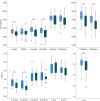Cognitive outcome and its neural correlates after cardiorespiratory arrest in childhood
- PMID: 38558493
- PMCID: PMC11753495
- DOI: 10.1111/desc.13501
Cognitive outcome and its neural correlates after cardiorespiratory arrest in childhood
Abstract
Hypoxia-ischaemia (HI) can result in structural brain abnormalities, which in turn can lead to behavioural deficits in various cognitive and motor domains, in both adult and paediatric populations. Cardiorespiratory arrest (CA) is a major cause of hypoxia-ischaemia in adults, but it is relatively rare in infants and children. While the effects of adult CA on brain and cognition have been widely studied, to date, there are no studies examining the neurodevelopmental outcome of children who suffered CA early in life. Here, we studied the long-term outcome of 28 children who suffered early CA (i.e., before age 16). They were compared to a group of control participants (n = 28) matched for age, sex and socio-economic status. The patient group had impairments in the domains of memory, language and academic attainment (measured using standardised tests). Individual scores within the impaired range were most commonly found within the memory domain (79%), followed by academic attainment (50%), and language (36%). The patient group also had reduced whole brain grey matter volume, and reduced volume and fractional anisotropy of the white matter. In addition, lower performance on memory tests was correlated with bilaterally reduced volume of the hippocampi, thalami, and striatum, while lower attainment scores were correlated with bilateral reduction of fractional anisotropy in the superior cerebellar peduncle, the main output tract of the cerebellum. We conclude that patients who suffered early CA are at risk of developing specific cognitive deficits associated with structural brain abnormalities. RESEARCH HIGHLIGHTS: Our data shed light on the long-term outcome and associated neural mechanisms after paediatric hypoxia-ischaemia as a result of cardiorespiratory arrest. Patients had impaired scores on memory, language and academic attainment. Memory impairments were associated with smaller hippocampi, thalami, and striatum. Lower academic attainment correlated with reduced fractional anisotropy of the superior cerebellar peduncle.
Keywords: hippocampus; language; memory; striatum; thalamus.
© 2024 The Authors. Developmental Science published by John Wiley & Sons Ltd.
Conflict of interest statement
The authors declare no conflicts of interest.
Figures






Similar articles
-
Brain metabolite alterations in infants born preterm with intrauterine growth restriction: association with structural changes and neurodevelopmental outcome.Am J Obstet Gynecol. 2017 Jan;216(1):62.e1-62.e14. doi: 10.1016/j.ajog.2016.09.089. Epub 2016 Sep 22. Am J Obstet Gynecol. 2017. PMID: 27667762
-
Gray and White Matter Contributions to Cognitive Frontostriatal Deficits in Non-Demented Parkinson's Disease.PLoS One. 2016 Jan 19;11(1):e0147332. doi: 10.1371/journal.pone.0147332. eCollection 2016. PLoS One. 2016. PMID: 26784744 Free PMC article.
-
Association between the scores of the Japanese version of the Brief Assessment of Cognition in Schizophrenia and whole-brain structure in patients with chronic schizophrenia: A voxel-based morphometry and diffusion tensor imaging study.Psychiatry Clin Neurosci. 2017 Dec;71(12):826-835. doi: 10.1111/pcn.12560. Epub 2017 Sep 10. Psychiatry Clin Neurosci. 2017. PMID: 28755401
-
Mammillary body atrophy and other MRI correlates of school-age outcome following neonatal hypoxic-ischemic encephalopathy.Sci Rep. 2021 Mar 3;11(1):5017. doi: 10.1038/s41598-021-83982-8. Sci Rep. 2021. PMID: 33658541 Free PMC article.
-
Visual-motor deficits relate to altered gray and white matter in young adults born preterm with very low birth weight.Neuroimage. 2015 Apr 1;109:493-504. doi: 10.1016/j.neuroimage.2015.01.019. Epub 2015 Jan 13. Neuroimage. 2015. PMID: 25592994
Cited by
-
Perinatal hypoxia-mediated neurodevelopment abnormalities in congenital heart disease mouse model.Mol Med. 2025 Mar 21;31(1):109. doi: 10.1186/s10020-025-01158-w. Mol Med. 2025. PMID: 40114103 Free PMC article.
References
-
- Albazron, F. M. , Bruss, J. , Jones, R. M. , Yock, T. I. , Pulsifer, M. B. , Cohen, A. L. , Nopoulos, P. C. , Abrams, A. N. , Sato, M. , & Boes, A. D. (2019). Pediatric postoperative cerebellar cognitive affective syndrome follows outflow pathway lesions. Neurology, 93(16), E1561–E1571. 10.1212/WNL.0000000000008326 - DOI - PMC - PubMed
-
- Alonso, K. W. , Dahhan, N. Z. A. , Riggs, L. , Tseng, J. , de Medeiros, C. , Scott, M. , Laughlin, S. , Bouffet, E. , & Mabbott, D. J. (2023). Network connectivity underlying episodic memory in children: Application of a pediatric brain tumor survivor injury model. Developmental Science, 27(1), e13413. 10.1111/desc.13413 - DOI - PubMed
MeSH terms
LinkOut - more resources
Full Text Sources
Medical

